University Project Management Methodologies Case Study Analysis
VerifiedAdded on 2020/03/13
|6
|1058
|119
Case Study
AI Summary
This case study examines a project management failure involving Rapid Prototyping (RP) equipment. Frank, an entrepreneur, was contracted to develop RP equipment for Cocable. The project encountered numerous issues, including unclear goals, lack of scope verification, and the absence of project management methodologies. The case study analyzes these problems, pinpointing their causes, such as poor stakeholder management, inadequate communication, and insufficient risk assessment. Recommendations include rigorous scope verification, the adoption of project management methodologies, and a focus on stakeholder expectations. The lessons learned emphasize the importance of thorough scope checking and verification to prevent rework and ensure project success. The analysis concludes by highlighting the shared responsibility of all stakeholders—GE, Cocable, and Frank—for the project's shortcomings and the critical need for structured project management practices.
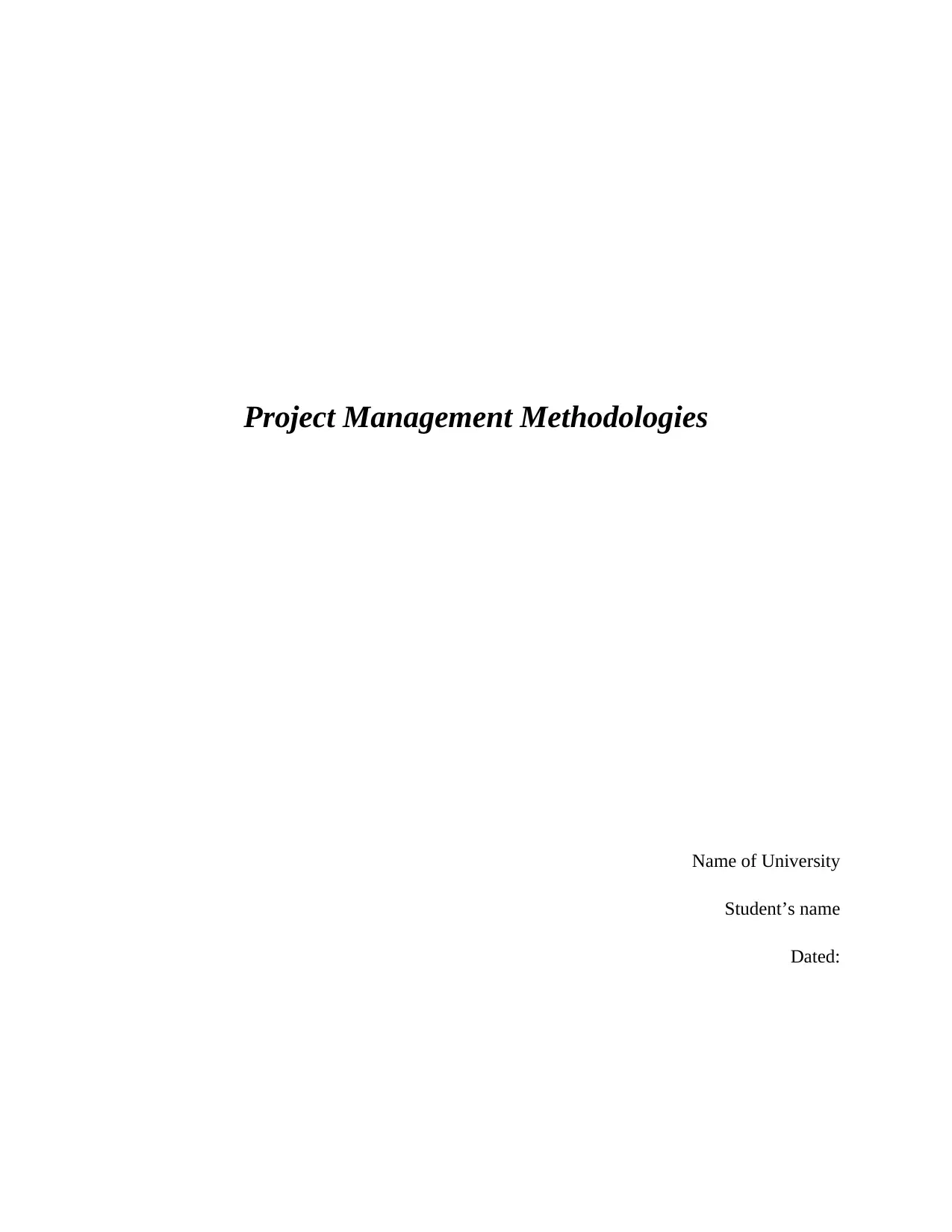
Project Management Methodologies
Name of University
Student’s name
Dated:
Name of University
Student’s name
Dated:
Paraphrase This Document
Need a fresh take? Get an instant paraphrase of this document with our AI Paraphraser
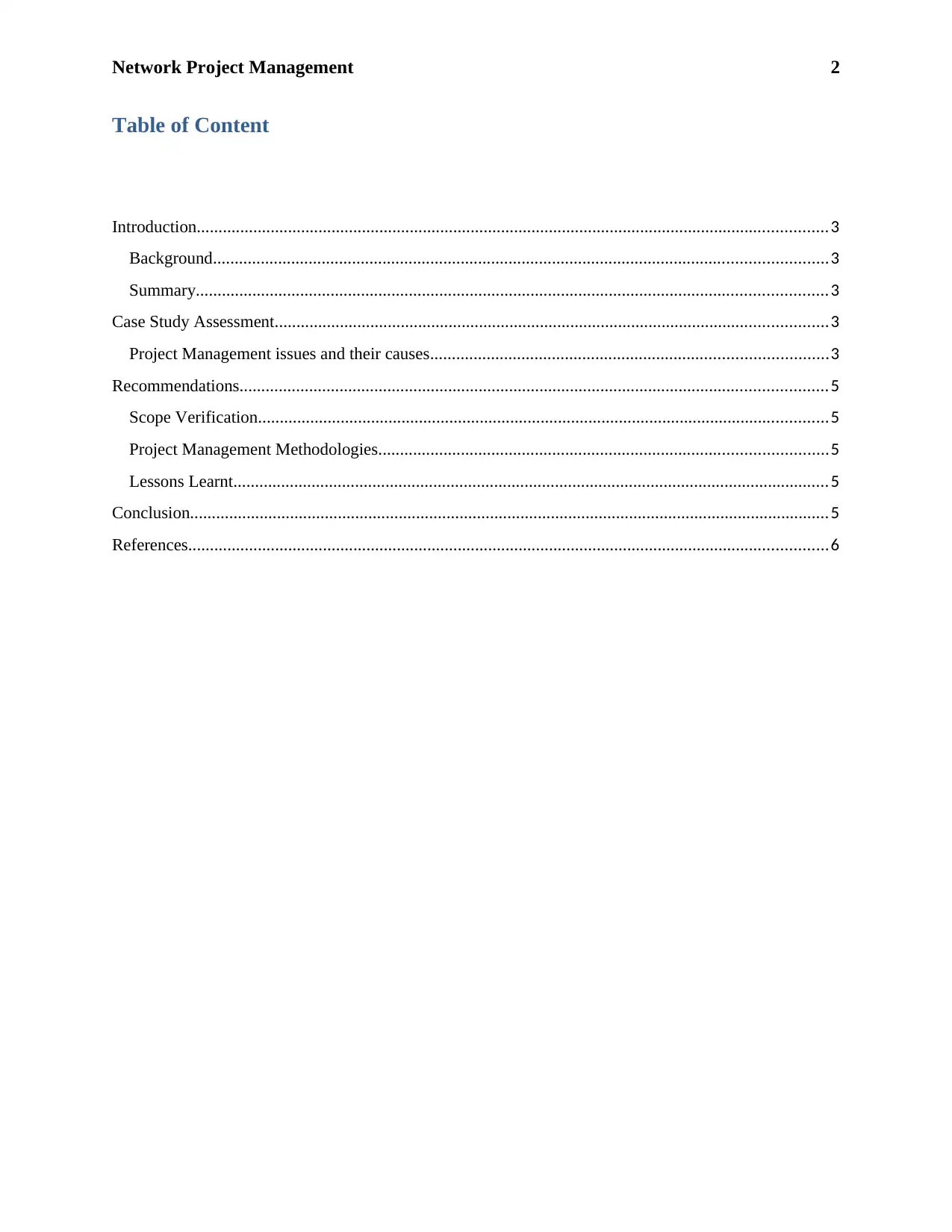
Network Project Management 2
Table of Content
Introduction.................................................................................................................................................3
Background.............................................................................................................................................3
Summary.................................................................................................................................................3
Case Study Assessment...............................................................................................................................3
Project Management issues and their causes...........................................................................................3
Recommendations.......................................................................................................................................5
Scope Verification...................................................................................................................................5
Project Management Methodologies.......................................................................................................5
Lessons Learnt.........................................................................................................................................5
Conclusion...................................................................................................................................................5
References...................................................................................................................................................6
Table of Content
Introduction.................................................................................................................................................3
Background.............................................................................................................................................3
Summary.................................................................................................................................................3
Case Study Assessment...............................................................................................................................3
Project Management issues and their causes...........................................................................................3
Recommendations.......................................................................................................................................5
Scope Verification...................................................................................................................................5
Project Management Methodologies.......................................................................................................5
Lessons Learnt.........................................................................................................................................5
Conclusion...................................................................................................................................................5
References...................................................................................................................................................6
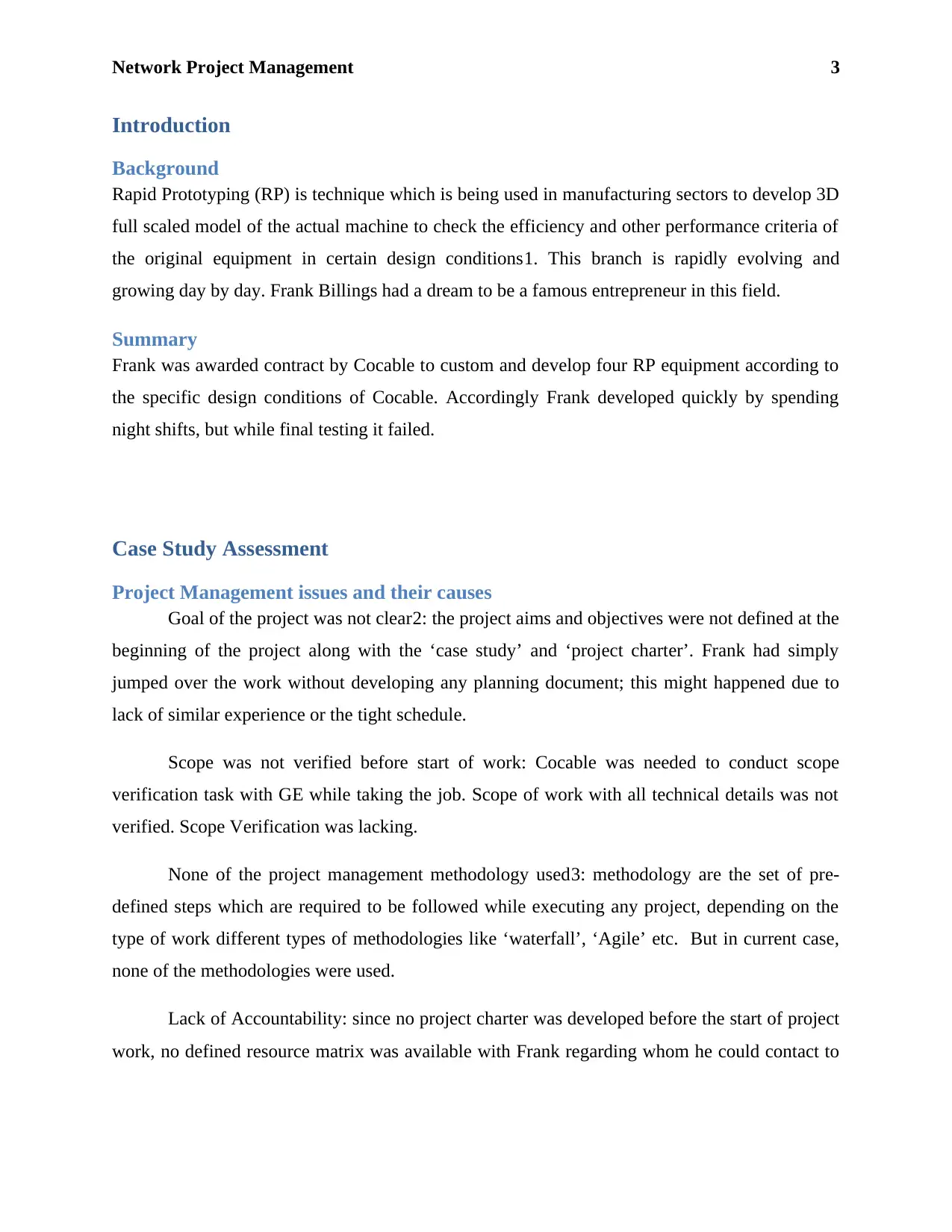
Network Project Management 3
Introduction
Background
Rapid Prototyping (RP) is technique which is being used in manufacturing sectors to develop 3D
full scaled model of the actual machine to check the efficiency and other performance criteria of
the original equipment in certain design conditions1. This branch is rapidly evolving and
growing day by day. Frank Billings had a dream to be a famous entrepreneur in this field.
Summary
Frank was awarded contract by Cocable to custom and develop four RP equipment according to
the specific design conditions of Cocable. Accordingly Frank developed quickly by spending
night shifts, but while final testing it failed.
Case Study Assessment
Project Management issues and their causes
Goal of the project was not clear2: the project aims and objectives were not defined at the
beginning of the project along with the ‘case study’ and ‘project charter’. Frank had simply
jumped over the work without developing any planning document; this might happened due to
lack of similar experience or the tight schedule.
Scope was not verified before start of work: Cocable was needed to conduct scope
verification task with GE while taking the job. Scope of work with all technical details was not
verified. Scope Verification was lacking.
None of the project management methodology used3: methodology are the set of pre-
defined steps which are required to be followed while executing any project, depending on the
type of work different types of methodologies like ‘waterfall’, ‘Agile’ etc. But in current case,
none of the methodologies were used.
Lack of Accountability: since no project charter was developed before the start of project
work, no defined resource matrix was available with Frank regarding whom he could contact to
Introduction
Background
Rapid Prototyping (RP) is technique which is being used in manufacturing sectors to develop 3D
full scaled model of the actual machine to check the efficiency and other performance criteria of
the original equipment in certain design conditions1. This branch is rapidly evolving and
growing day by day. Frank Billings had a dream to be a famous entrepreneur in this field.
Summary
Frank was awarded contract by Cocable to custom and develop four RP equipment according to
the specific design conditions of Cocable. Accordingly Frank developed quickly by spending
night shifts, but while final testing it failed.
Case Study Assessment
Project Management issues and their causes
Goal of the project was not clear2: the project aims and objectives were not defined at the
beginning of the project along with the ‘case study’ and ‘project charter’. Frank had simply
jumped over the work without developing any planning document; this might happened due to
lack of similar experience or the tight schedule.
Scope was not verified before start of work: Cocable was needed to conduct scope
verification task with GE while taking the job. Scope of work with all technical details was not
verified. Scope Verification was lacking.
None of the project management methodology used3: methodology are the set of pre-
defined steps which are required to be followed while executing any project, depending on the
type of work different types of methodologies like ‘waterfall’, ‘Agile’ etc. But in current case,
none of the methodologies were used.
Lack of Accountability: since no project charter was developed before the start of project
work, no defined resource matrix was available with Frank regarding whom he could contact to
⊘ This is a preview!⊘
Do you want full access?
Subscribe today to unlock all pages.

Trusted by 1+ million students worldwide
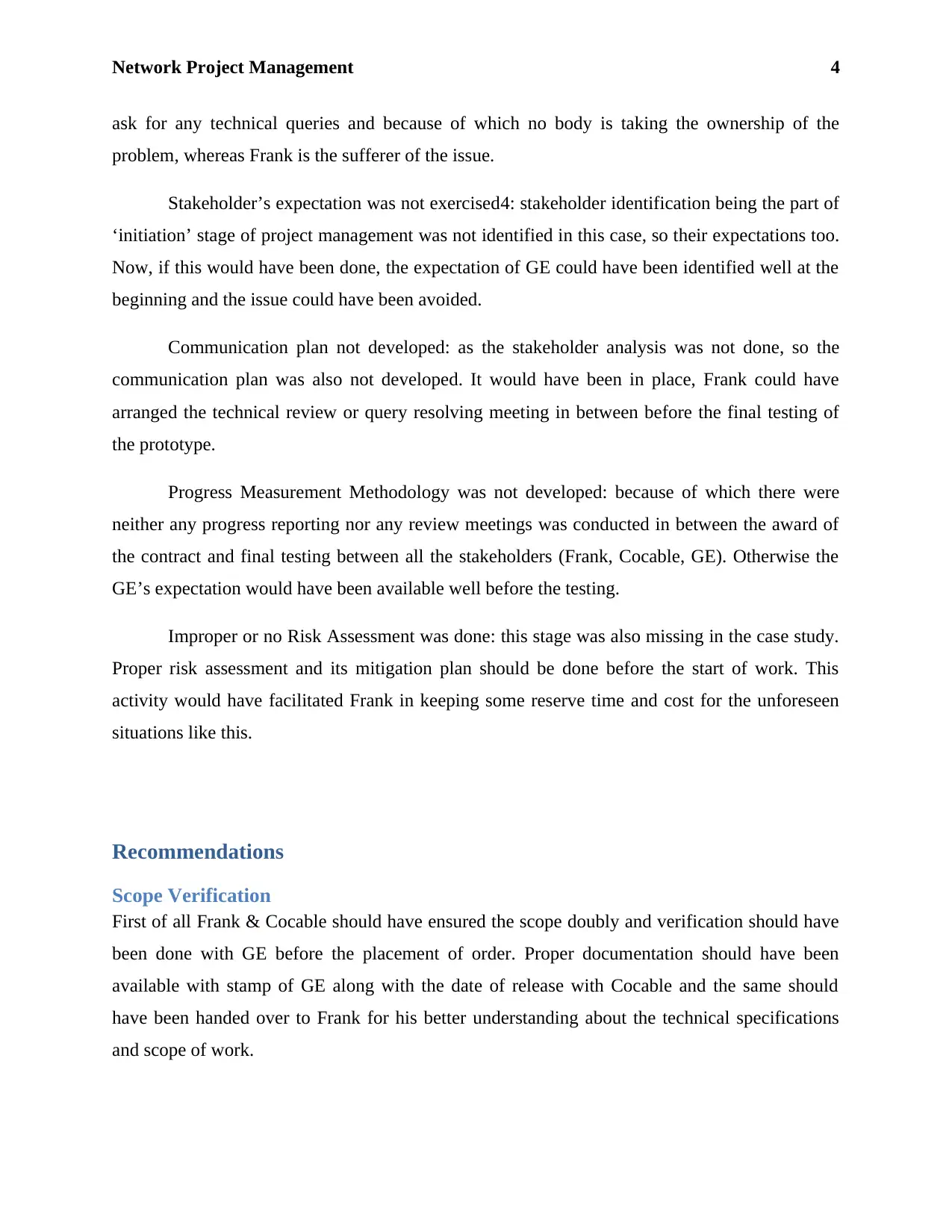
Network Project Management 4
ask for any technical queries and because of which no body is taking the ownership of the
problem, whereas Frank is the sufferer of the issue.
Stakeholder’s expectation was not exercised4: stakeholder identification being the part of
‘initiation’ stage of project management was not identified in this case, so their expectations too.
Now, if this would have been done, the expectation of GE could have been identified well at the
beginning and the issue could have been avoided.
Communication plan not developed: as the stakeholder analysis was not done, so the
communication plan was also not developed. It would have been in place, Frank could have
arranged the technical review or query resolving meeting in between before the final testing of
the prototype.
Progress Measurement Methodology was not developed: because of which there were
neither any progress reporting nor any review meetings was conducted in between the award of
the contract and final testing between all the stakeholders (Frank, Cocable, GE). Otherwise the
GE’s expectation would have been available well before the testing.
Improper or no Risk Assessment was done: this stage was also missing in the case study.
Proper risk assessment and its mitigation plan should be done before the start of work. This
activity would have facilitated Frank in keeping some reserve time and cost for the unforeseen
situations like this.
Recommendations
Scope Verification
First of all Frank & Cocable should have ensured the scope doubly and verification should have
been done with GE before the placement of order. Proper documentation should have been
available with stamp of GE along with the date of release with Cocable and the same should
have been handed over to Frank for his better understanding about the technical specifications
and scope of work.
ask for any technical queries and because of which no body is taking the ownership of the
problem, whereas Frank is the sufferer of the issue.
Stakeholder’s expectation was not exercised4: stakeholder identification being the part of
‘initiation’ stage of project management was not identified in this case, so their expectations too.
Now, if this would have been done, the expectation of GE could have been identified well at the
beginning and the issue could have been avoided.
Communication plan not developed: as the stakeholder analysis was not done, so the
communication plan was also not developed. It would have been in place, Frank could have
arranged the technical review or query resolving meeting in between before the final testing of
the prototype.
Progress Measurement Methodology was not developed: because of which there were
neither any progress reporting nor any review meetings was conducted in between the award of
the contract and final testing between all the stakeholders (Frank, Cocable, GE). Otherwise the
GE’s expectation would have been available well before the testing.
Improper or no Risk Assessment was done: this stage was also missing in the case study.
Proper risk assessment and its mitigation plan should be done before the start of work. This
activity would have facilitated Frank in keeping some reserve time and cost for the unforeseen
situations like this.
Recommendations
Scope Verification
First of all Frank & Cocable should have ensured the scope doubly and verification should have
been done with GE before the placement of order. Proper documentation should have been
available with stamp of GE along with the date of release with Cocable and the same should
have been handed over to Frank for his better understanding about the technical specifications
and scope of work.
Paraphrase This Document
Need a fresh take? Get an instant paraphrase of this document with our AI Paraphraser
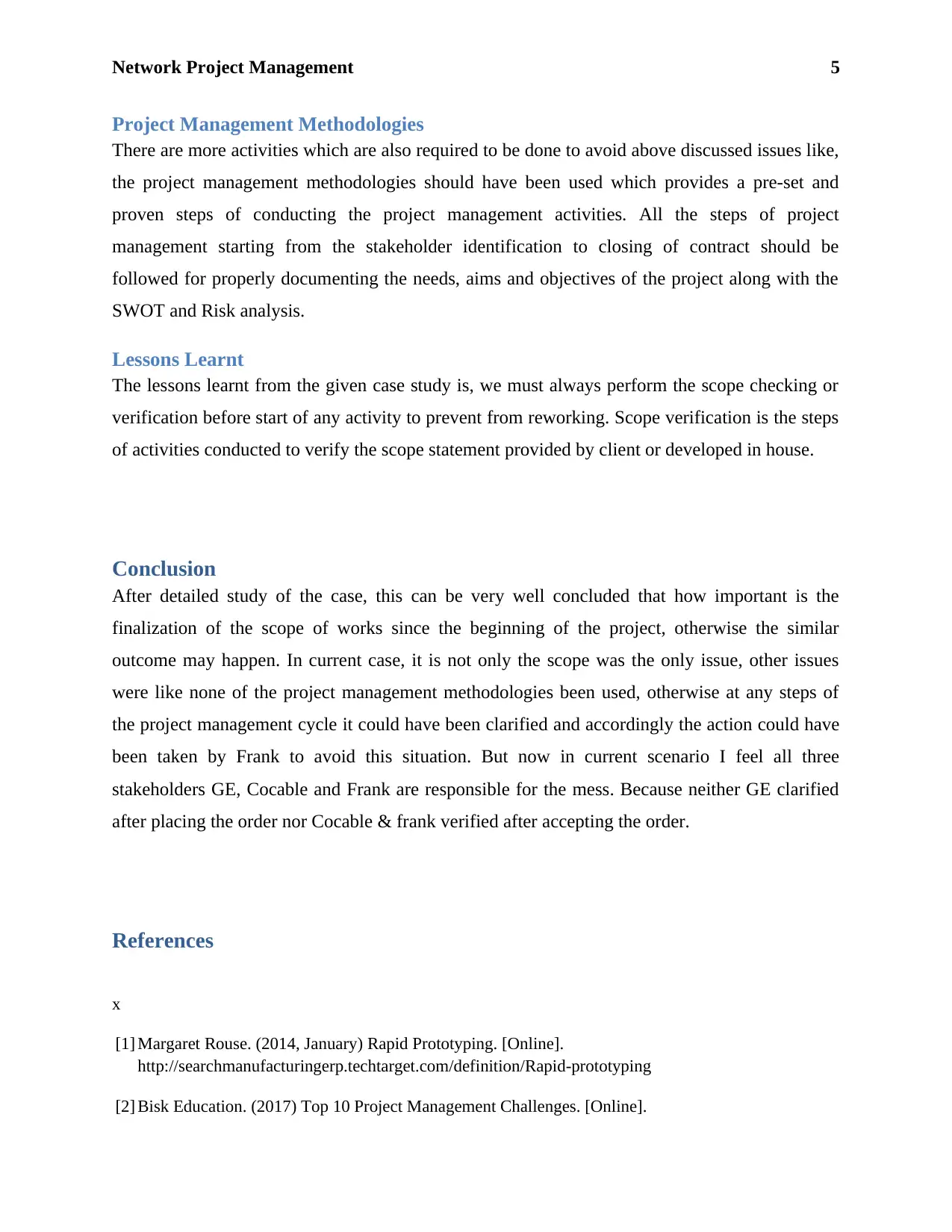
Network Project Management 5
Project Management Methodologies
There are more activities which are also required to be done to avoid above discussed issues like,
the project management methodologies should have been used which provides a pre-set and
proven steps of conducting the project management activities. All the steps of project
management starting from the stakeholder identification to closing of contract should be
followed for properly documenting the needs, aims and objectives of the project along with the
SWOT and Risk analysis.
Lessons Learnt
The lessons learnt from the given case study is, we must always perform the scope checking or
verification before start of any activity to prevent from reworking. Scope verification is the steps
of activities conducted to verify the scope statement provided by client or developed in house.
Conclusion
After detailed study of the case, this can be very well concluded that how important is the
finalization of the scope of works since the beginning of the project, otherwise the similar
outcome may happen. In current case, it is not only the scope was the only issue, other issues
were like none of the project management methodologies been used, otherwise at any steps of
the project management cycle it could have been clarified and accordingly the action could have
been taken by Frank to avoid this situation. But now in current scenario I feel all three
stakeholders GE, Cocable and Frank are responsible for the mess. Because neither GE clarified
after placing the order nor Cocable & frank verified after accepting the order.
References
x
[1] Margaret Rouse. (2014, January) Rapid Prototyping. [Online].
http://searchmanufacturingerp.techtarget.com/definition/Rapid-prototyping
[2] Bisk Education. (2017) Top 10 Project Management Challenges. [Online].
Project Management Methodologies
There are more activities which are also required to be done to avoid above discussed issues like,
the project management methodologies should have been used which provides a pre-set and
proven steps of conducting the project management activities. All the steps of project
management starting from the stakeholder identification to closing of contract should be
followed for properly documenting the needs, aims and objectives of the project along with the
SWOT and Risk analysis.
Lessons Learnt
The lessons learnt from the given case study is, we must always perform the scope checking or
verification before start of any activity to prevent from reworking. Scope verification is the steps
of activities conducted to verify the scope statement provided by client or developed in house.
Conclusion
After detailed study of the case, this can be very well concluded that how important is the
finalization of the scope of works since the beginning of the project, otherwise the similar
outcome may happen. In current case, it is not only the scope was the only issue, other issues
were like none of the project management methodologies been used, otherwise at any steps of
the project management cycle it could have been clarified and accordingly the action could have
been taken by Frank to avoid this situation. But now in current scenario I feel all three
stakeholders GE, Cocable and Frank are responsible for the mess. Because neither GE clarified
after placing the order nor Cocable & frank verified after accepting the order.
References
x
[1] Margaret Rouse. (2014, January) Rapid Prototyping. [Online].
http://searchmanufacturingerp.techtarget.com/definition/Rapid-prototyping
[2] Bisk Education. (2017) Top 10 Project Management Challenges. [Online].
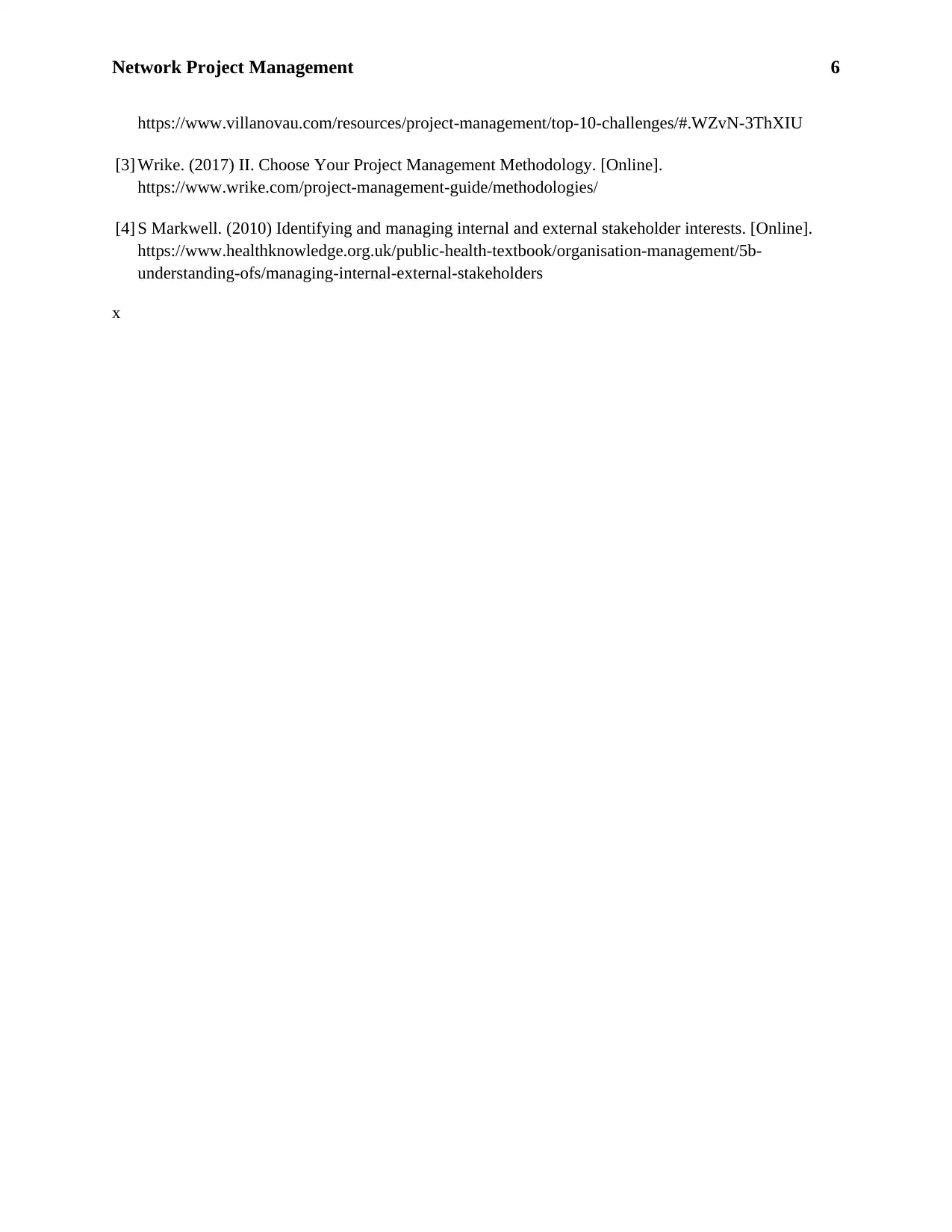
Network Project Management 6
https://www.villanovau.com/resources/project-management/top-10-challenges/#.WZvN-3ThXIU
[3] Wrike. (2017) II. Choose Your Project Management Methodology. [Online].
https://www.wrike.com/project-management-guide/methodologies/
[4] S Markwell. (2010) Identifying and managing internal and external stakeholder interests. [Online].
https://www.healthknowledge.org.uk/public-health-textbook/organisation-management/5b-
understanding-ofs/managing-internal-external-stakeholders
x
https://www.villanovau.com/resources/project-management/top-10-challenges/#.WZvN-3ThXIU
[3] Wrike. (2017) II. Choose Your Project Management Methodology. [Online].
https://www.wrike.com/project-management-guide/methodologies/
[4] S Markwell. (2010) Identifying and managing internal and external stakeholder interests. [Online].
https://www.healthknowledge.org.uk/public-health-textbook/organisation-management/5b-
understanding-ofs/managing-internal-external-stakeholders
x
⊘ This is a preview!⊘
Do you want full access?
Subscribe today to unlock all pages.

Trusted by 1+ million students worldwide
1 out of 6
Related Documents
Your All-in-One AI-Powered Toolkit for Academic Success.
+13062052269
info@desklib.com
Available 24*7 on WhatsApp / Email
![[object Object]](/_next/static/media/star-bottom.7253800d.svg)
Unlock your academic potential
Copyright © 2020–2025 A2Z Services. All Rights Reserved. Developed and managed by ZUCOL.





